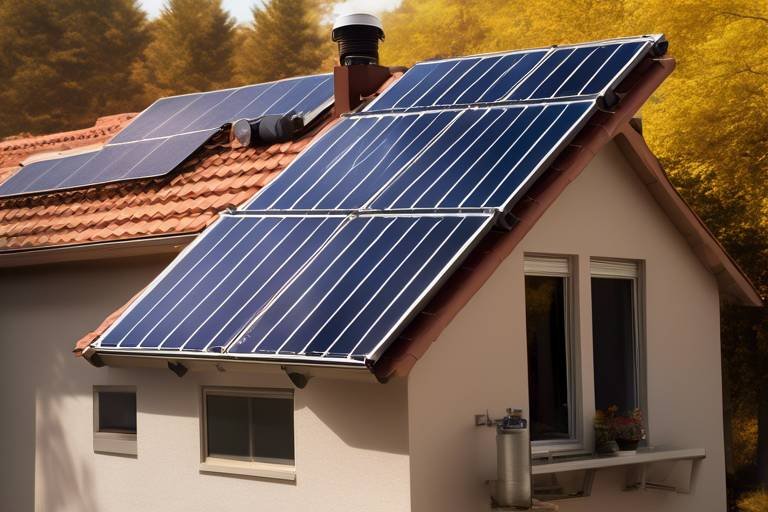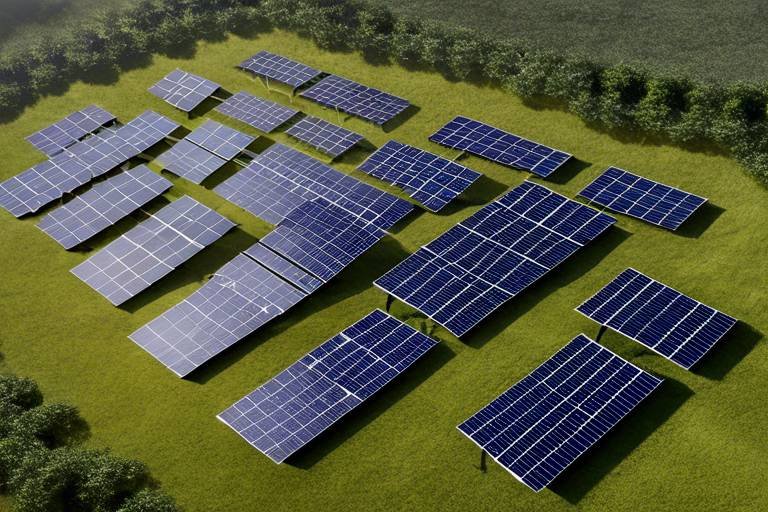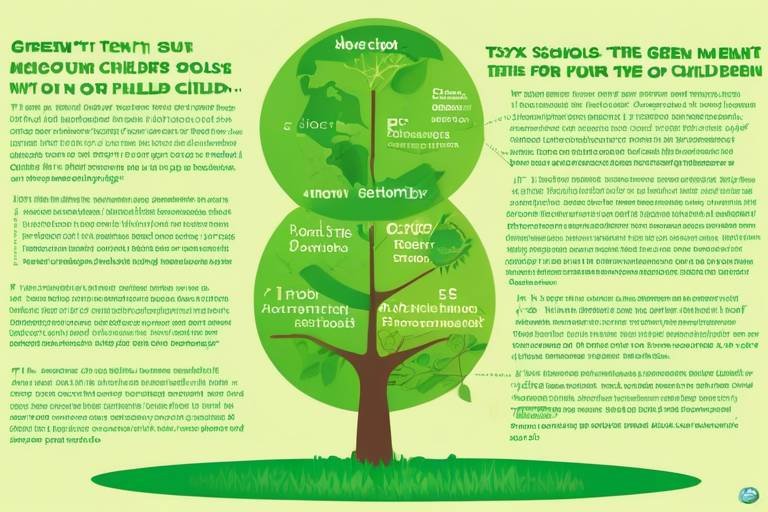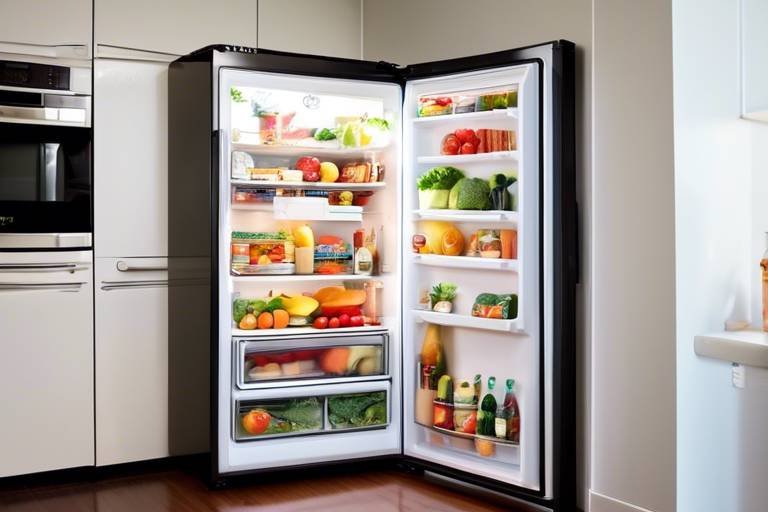Sustainable Home Office Setup Guide
In today's world, where environmental consciousness is at an all-time high, creating a sustainable home office is more than just a trend—it's a necessity. With the rise of remote work, many of us find ourselves spending countless hours in our home offices. So, why not make that space not only functional but also eco-friendly? This guide provides insights on creating an eco-friendly home office, focusing on sustainable materials, energy efficiency, and practices that promote a healthier work environment while minimizing environmental impact. Think of your home office as a sanctuary where productivity meets sustainability, and every choice you make can lead to a greener planet.
When it comes to setting up your home office, the furniture you choose plays a pivotal role. Selecting furniture made from sustainable materials not only reduces your carbon footprint but also enhances the aesthetic of your workspace. Consider options like reclaimed wood, which tells a story of its past while providing a unique character to your office. Bamboo is another excellent choice; it's fast-growing and incredibly durable. You might also want to look for products that are certified sustainable, ensuring that they come from responsibly managed forests. Remember, investing in eco-friendly furniture is not just about sustainability—it's about creating a space that inspires you.
Lighting plays a crucial role in a home office. Imagine working in a space that feels as bright as a sunny day—this is achievable with energy-efficient lighting solutions. Opt for LED bulbs, which consume significantly less energy than traditional incandescent bulbs and last much longer. Additionally, maximizing natural light can create a bright, inviting space that not only reduces electricity consumption but also enhances productivity. Consider positioning your desk near a window or using light-colored curtains to allow sunlight to filter in. Your eyes will thank you, and so will the planet!
Adding indoor plants is a game-changer for both air quality and your overall mood. Plants like snake plants, peace lilies, and pothos are not only low-maintenance but also thrive in indoor environments. They act as natural air purifiers, absorbing toxins and releasing oxygen, which creates a calming atmosphere while contributing to a healthier workspace. Imagine the fresh feeling of a forest in your office—it's not just a dream! By incorporating plants, you can transform your workspace into a vibrant, green haven that promotes well-being.
In our tech-driven world, smart devices can help monitor energy use and optimize efficiency in your home office. Consider investing in smart thermostats that learn your schedule and adjust heating and cooling accordingly, or energy monitors that track your consumption patterns. Automated lighting systems can also help you save energy by adjusting the light levels based on the time of day or occupancy. By integrating smart technology, you're not just making your office more sustainable; you're also creating a more responsive and user-friendly environment.
Minimizing waste is essential for sustainability. Implementing strategies like digital documentation can significantly reduce paper waste. Why print when you can store files digitally? Additionally, consider setting up a recycling program in your office. Use refillable supplies, such as pens and ink cartridges, to cut down on single-use plastics. By adopting these practices, you contribute to a larger movement toward reducing environmental impact, proving that small changes can lead to significant results.
When it comes to office supplies, opting for eco-friendly options made from recycled materials or sustainably sourced components is a straightforward yet impactful choice. Look for items like recycled paper, biodegradable binders, and refillable notebooks. This simple change can significantly reduce your office's environmental footprint while still maintaining functionality. Plus, you’ll feel good knowing that your supplies are contributing to a healthier planet. It's like giving your workspace a green makeover!
A minimalist approach not only declutters your space but also promotes sustainability. Focus on essential items and avoid excess, which can lead to a more efficient and eco-conscious work environment. Think of your workspace as a blank canvas—by keeping it simple, you allow your creativity to flourish. A clean and organized office can help you work more effectively, reducing stress and increasing productivity. Remember, less is often more!
Encouraging remote work can significantly reduce commuting emissions. Highlight the benefits of flexible work arrangements to foster a sustainable work culture that prioritizes both productivity and environmental responsibility. When employees work from home, they save time, reduce stress, and contribute to lower carbon footprints. It's a win-win situation! By promoting remote work practices, you’re not just supporting your team; you’re also making a positive impact on the environment.
Establishing long-term sustainability goals for your home office can guide your efforts. Regularly assess your practices and make adjustments to ensure continuous improvement in reducing your environmental impact. Set measurable goals, like reducing paper use by a certain percentage or committing to buying only sustainable office supplies. By holding yourself accountable, you can create a workspace that evolves with your values and contributes to a greener future.
- What are some easy ways to make my home office more sustainable?
Start by choosing eco-friendly furniture, using energy-efficient lighting, and incorporating plants for better air quality. - How can I reduce waste in my home office?
Implement digital documentation, recycle materials, and use refillable supplies to minimize waste. - Are there specific plants that are better for indoor air quality?
Yes, plants like snake plants, peace lilies, and pothos are great options for improving air quality.

Choosing Eco-Friendly Furniture
When it comes to setting up a sustainable home office, one of the most impactful decisions you'll make is . Not only does this choice help reduce your carbon footprint, but it also contributes to a healthier work environment. Imagine walking into a workspace that not only looks good but feels good too—this is the magic of sustainable furniture!
So, what exactly qualifies as eco-friendly furniture? Well, it primarily includes items made from sustainable materials like reclaimed wood, bamboo, or products certified by organizations such as the Forest Stewardship Council (FSC). Reclaimed wood, for instance, is a fantastic option. It gives new life to materials that might otherwise end up in a landfill, and each piece tells a story. Bamboo is another excellent choice; it grows incredibly fast and can be harvested without damaging the ecosystem, making it a renewable resource.
Additionally, consider the manufacturing process. Many companies are now adopting sustainable practices that minimize waste and reduce energy consumption. Look for brands that prioritize low-VOC (volatile organic compounds) finishes, which are better for indoor air quality. You don’t want to be breathing in harmful chemicals while trying to focus on your work!
When selecting your furniture, think about the design as well. Aesthetics play a crucial role in creating an inspiring workspace. Eco-friendly furniture often features clean lines and natural finishes that can enhance your office's overall look. For instance, a sleek, bamboo desk paired with a comfortable, recycled fabric chair can create a harmonious and inviting atmosphere.
Another important aspect is durability. Invest in high-quality pieces that will last for years rather than opting for cheaper, mass-produced items that may need replacing sooner. This approach not only saves you money in the long run but also contributes to a more sustainable lifestyle. Remember, every piece of furniture you choose is a reflection of your commitment to the environment.
Before making a purchase, it can be helpful to research various brands and their sustainability practices. Here’s a quick comparison table of some popular eco-friendly furniture materials:
| Material | Benefits | Considerations |
|---|---|---|
| Reclaimed Wood | Unique character, reduces waste | May require more maintenance |
| Bamboo | Fast-growing, renewable resource | Quality can vary by manufacturer |
| Recycled Metal | Durable, often stylish | Can be heavier than other options |
| Low-VOC Finishes | Better for indoor air quality | May have a higher upfront cost |
In conclusion, choosing eco-friendly furniture is not just about making a responsible choice; it's about creating a workspace that inspires you every day while being kind to our planet. So the next time you're in the market for office furniture, remember to look for sustainable materials, consider the manufacturing process, and invest in quality pieces that will stand the test of time. Your home office will not only look great, but it will also reflect your commitment to a healthier, more sustainable future.

Energy-Efficient Lighting Solutions
When it comes to setting up a sustainable home office, lighting is often an overlooked hero. The right lighting can transform your workspace into a vibrant environment that not only enhances your productivity but also reduces your energy consumption. Imagine stepping into a bright, inviting room filled with natural light, where every corner is illuminated without the harsh glare of traditional bulbs. Sounds dreamy, right? Well, it’s entirely possible with energy-efficient lighting solutions!
First off, let’s talk about LED bulbs. These little wonders are not just energy savers; they can last up to 25 times longer than incandescent bulbs. That means fewer trips to the store and less waste in landfills. Plus, they come in various styles and colors, allowing you to customize your workspace to reflect your personality. Whether you prefer a warm glow or a cooler, more focused light, there’s an LED option for you!
But wait, there’s more! Have you considered maximizing natural light? Positioning your desk near a window can significantly reduce your reliance on artificial lighting during the day. Not only does natural light boost your mood, but it can also enhance your creativity. Think of it as a free source of energy that’s good for both you and the planet. To further enhance this effect, use light-colored walls and reflective surfaces to bounce that glorious sunlight around your space.
Another game-changer in the realm of energy efficiency is the use of smart lighting systems. These nifty devices allow you to control your lighting with your smartphone or voice commands, making it easy to adjust brightness levels based on your needs. Imagine being able to dim the lights for a video call or brighten them up when you need to focus on a report—all with just a few taps or a simple command! Smart lighting not only improves convenience but can also help you track and reduce your energy consumption over time.
Now, you might be wondering about the cost. While it’s true that energy-efficient solutions may require a higher initial investment, think of it as a long-term savings plan. LED bulbs and smart lighting systems can significantly lower your electricity bills, paying for themselves over time. To illustrate this, let’s take a look at a simple table comparing the costs and longevity of different lighting options:
| Lighting Type | Average Lifespan (Hours) | Cost per Bulb | Annual Energy Cost |
|---|---|---|---|
| Incandescent | 1,000 | $1.00 | $10.00 |
| Compact Fluorescent (CFL) | 10,000 | $3.00 | $5.00 |
| LED | 25,000 | $10.00 | $2.00 |
As you can see, while LED bulbs have a higher upfront cost, their longevity and lower energy costs make them the most economical choice in the long run. So, why not make the switch today? Your wallet and the environment will thank you!
In conclusion, lighting is a crucial component of a sustainable home office setup. By choosing energy-efficient lighting solutions, maximizing natural light, and embracing smart technology, you can create a workspace that is not only eco-friendly but also enhances your productivity and well-being. So go ahead, light up your life the sustainable way!
Q: What are the benefits of using LED bulbs over traditional incandescent bulbs?
A: LED bulbs use significantly less energy, last much longer, and help reduce your electricity bills. They also come in various styles to suit your aesthetic needs.
Q: How can I maximize natural light in my home office?
A: Position your desk near windows, use light-colored walls, and incorporate mirrors or reflective surfaces to enhance the flow of natural light in your workspace.
Q: Are smart lighting systems worth the investment?
A: Yes! Smart lighting systems offer convenience, energy savings, and the ability to customize your lighting based on your activities, making them a worthwhile investment for a sustainable home office.

Incorporating Plants for Air Quality
When it comes to creating a sustainable home office, one of the most delightful and effective strategies is incorporating plants into your workspace. Not only do plants add a splash of color and life to your environment, but they also play a crucial role in improving air quality. Imagine transforming your dull office into a vibrant oasis where the air feels fresher and your mood is uplifted. It's like bringing a piece of nature indoors, and the benefits are numerous!
Plants are natural air purifiers. They absorb carbon dioxide and release oxygen, which is essential for maintaining a healthy atmosphere. Some studies even suggest that certain indoor plants can remove harmful toxins such as formaldehyde, benzene, and trichloroethylene from the air. This is particularly important in a home office where you might spend long hours working and breathing in potentially harmful air. So, why not surround yourself with a few green companions that can help you breathe easier?
When selecting plants for your home office, consider low-maintenance options that thrive indoors. Here are a few popular choices:
- Snake Plant: Known for its resilience, the snake plant can survive in low light and requires minimal watering.
- Pothos: This trailing vine is not only beautiful but also effective at purifying the air.
- Spider Plant: A fantastic air purifier, spider plants can adapt to various conditions and are safe for pets.
- Peace Lily: With its elegant white flowers, the peace lily is great at filtering out harmful chemicals.
Incorporating these plants into your workspace can create a calming atmosphere that enhances productivity. Imagine the gentle sway of leaves as you work, or the subtle fragrance of a flowering plant wafting through the air. It's not just about aesthetics; it’s about creating a healthier work environment that fosters creativity and focus.
Additionally, plants can help reduce stress and increase overall well-being. Studies have shown that being around greenery can lower blood pressure and improve mood. So, when you're feeling overwhelmed by deadlines or projects, take a moment to appreciate the greenery around you. It’s like having a natural stress reliever right at your fingertips!
To maximize the benefits of your indoor plants, consider arranging them in a way that allows for optimal light exposure. A plant shelf or a sunny windowsill can be the perfect spot for your leafy friends. You might also want to rotate them occasionally to ensure they receive even sunlight, promoting healthy growth. Remember, a little care goes a long way in keeping your plants thriving and your air quality at its best.
In conclusion, incorporating plants into your home office is a simple yet powerful way to enhance air quality and create a more inviting workspace. By choosing the right plants and taking care of them, you can enjoy a refreshing environment that not only looks good but also feels good. So, why not bring a bit of green into your daily grind? Your lungs—and your mind—will thank you!
1. What types of plants are best for improving air quality? Low-maintenance plants like snake plants, pothos, and peace lilies are excellent choices for improving air quality.
2. How many plants should I have in my home office? It depends on the size of your space, but generally, having a few well-placed plants can make a significant difference.
3. Do indoor plants require a lot of sunlight? Not necessarily. Many indoor plants thrive in low-light conditions, making them perfect for home offices.
4. How often should I water my office plants? This varies by plant type, but a good rule of thumb is to check the soil moisture. Water when the top inch of soil feels dry.

Implementing Smart Technology
In today's digital age, smart technology is revolutionizing how we approach our home offices. Imagine walking into your workspace and having the perfect lighting adjust automatically to suit your mood or tasks. Sounds like a dream, right? Well, with smart devices, that dream can become a reality! By incorporating smart technology into your home office, you can not only enhance your productivity but also contribute to a more sustainable environment.
One of the most impactful ways to implement smart technology is through the use of smart thermostats. These devices learn your heating and cooling preferences over time, adjusting the temperature based on your habits. For instance, if you usually work from 9 AM to 5 PM, the thermostat can automatically lower the heating or cooling when you’re not around, saving energy and reducing your utility bills. It’s like having a personal assistant dedicated to your comfort while being eco-friendly!
Another fantastic addition is energy monitors. These handy gadgets provide real-time data on your energy consumption, helping you identify patterns and make informed decisions about your usage. You might be surprised to learn just how much energy certain devices consume when left on. By tracking this information, you can implement changes that lead to significant energy savings. For example, if you notice your printer is a major energy hog, you might decide to turn it off when not in use, or replace it with a more energy-efficient model.
Automated lighting systems are also a game-changer. By utilizing smart bulbs and motion sensors, you can ensure that your lights are only on when needed. This not only saves electricity but also creates a more dynamic work environment. Imagine your lights gradually brightening as the sun sets, mimicking natural daylight to keep your energy levels up. Plus, with smart bulbs, you can easily adjust the color temperature to suit your work tasks, whether you need a cool, bright light for focused tasks or a warmer hue for brainstorming sessions.
To give you an idea of how these technologies can work together, here’s a quick overview:
| Smart Technology | Benefits |
|---|---|
| Smart Thermostats | Reduces energy consumption by learning your schedule and preferences. |
| Energy Monitors | Provides insights into energy usage, helping you identify waste. |
| Automated Lighting | Adjusts lighting based on occupancy and time of day, saving energy. |
By embracing these smart technologies, you’re not just enhancing your work experience; you're also taking significant steps towards sustainability. It’s like having a green thumb for technology! You can create a workspace that not only feels good but also does good for the planet. So, why wait? Start integrating these smart solutions into your home office today, and watch your productivity soar while minimizing your environmental impact!
Q: What is a smart thermostat, and how does it work?
A: A smart thermostat is a device that learns your heating and cooling preferences and adjusts the temperature automatically based on your habits. It connects to your Wi-Fi, allowing you to control it remotely through a smartphone app.
Q: How can energy monitors help me save money?
A: Energy monitors track your energy consumption in real-time, providing insights into which devices use the most energy. By identifying wasteful habits, you can make adjustments that lead to lower utility bills.
Q: Are smart lighting systems difficult to install?
A: Not at all! Most smart lighting systems are designed for easy installation. Many can be set up using existing fixtures and only require a compatible smart bulb or smart switch.

Waste Reduction Strategies
In the quest for a sustainable home office, waste reduction stands as a cornerstone of environmental responsibility. The reality is that every piece of paper, every plastic wrapper, and every unused item contributes to a larger problem of waste accumulation. So, how do we tackle this issue effectively? It starts with a mindset shift—one that prioritizes efficiency and conscious consumption. By implementing smart waste reduction strategies, you can create an eco-friendly workspace that not only looks good but also feels good to work in.
One of the first steps in waste reduction is to embrace digital documentation. Gone are the days when every note had to be jotted down on paper. With a plethora of apps and tools available, you can easily store your documents electronically. This not only saves trees but also keeps your workspace clutter-free. Imagine a world where your desk is devoid of stacks of paper—sounds refreshing, right?
Next, consider establishing a robust recycling program within your home office. Set up clearly labeled bins for different materials like paper, plastics, and metals. This simple act can drastically reduce the amount of waste that ends up in landfills. You might even want to take it a step further by incorporating composting for organic waste. Just think of it as giving back to the earth while reducing your garbage output.
Another effective strategy is to switch to refillable supplies. Instead of constantly buying new pens, markers, and notebooks, look for products that can be refilled or reused. This not only cuts down on waste but often saves you money in the long run. For example, a refillable ink pen might cost a bit more upfront, but the savings from not buying disposable pens every few weeks will add up quickly.
Finally, it's essential to regularly assess your office supplies and equipment. Are there items that you rarely use? If so, consider donating them or selling them online. This not only declutters your space but also gives those items a new life. Remember, every little step counts in your journey toward sustainability. By implementing these waste reduction strategies, you'll not only create a more efficient workspace but also contribute to a healthier planet.
- What are some easy ways to reduce waste in my home office?
Start by going digital with your documents, recycling materials properly, and opting for refillable office supplies.
- How can I encourage my colleagues to adopt waste reduction practices?
Share your strategies and successes, and consider organizing workshops to educate them on the benefits of sustainability.
- Is it expensive to create a sustainable home office?
While some eco-friendly products may have a higher upfront cost, the long-term savings and environmental benefits often outweigh the initial investment.

Choosing Sustainable Office Supplies
When it comes to setting up a sustainable home office, one of the most impactful changes you can make is in your choice of office supplies. This might seem trivial, but the materials that make up your pens, paper, and other essentials can significantly affect the environment. By opting for eco-friendly office supplies, you not only reduce your carbon footprint but also inspire others around you to make similar choices.
First off, let's talk about paper. Traditional paper production is notorious for its environmental impact, from deforestation to water pollution. Instead, consider using recycled paper or paper made from sustainable sources, such as bamboo or sugarcane. Not only do these options help preserve our forests, but they also often come with a lower carbon footprint. Additionally, using digital documentation whenever possible can drastically cut down on paper waste. Think about it: how many times have you printed out documents that ended up in the recycling bin? Making the switch to a digital-first approach can save trees and declutter your workspace.
Next on the list are writing instruments. Many pens and markers are made from plastic, which contributes to landfill waste. Instead, look for refillable pens or those made from recycled materials. Brands that focus on sustainability often offer products that can be reused, thus minimizing waste. Imagine the difference it would make if everyone switched to refillable options—less plastic waste and a cleaner planet!
Another area to consider is your sticky notes and notepads. Instead of the standard sticky notes that are often made from virgin paper and coated with adhesives that aren't eco-friendly, seek out biodegradable sticky notes or those made from recycled paper. These alternatives serve the same purpose while being kinder to the environment. You can even find options that use natural adhesives, which break down more easily than traditional ones.
In addition to these supplies, think about your organizational tools. Folders, binders, and other storage solutions can also be sustainable. Look for products made from recycled materials or those that are designed to be durable and long-lasting. Investing in quality items means you won’t have to replace them as often, leading to less waste over time. Plus, a well-organized workspace can enhance your productivity, making it a win-win situation!
Lastly, it's essential to consider the packaging that comes with your office supplies. Many companies are now focusing on reducing packaging waste by using recyclable or compostable materials. When shopping, look for brands that prioritize sustainability in their packaging. This small change can have a ripple effect, encouraging manufacturers to adopt more eco-friendly practices.
In conclusion, choosing sustainable office supplies is a straightforward yet powerful way to contribute to a healthier planet. By being mindful of the materials you use, you can create a workspace that not only reflects your values but also inspires others to join you on this eco-friendly journey. So next time you’re stocking up on supplies, remember: every little choice counts!
Q: What are some examples of sustainable office supplies?
A: Sustainable office supplies include recycled paper, refillable pens, biodegradable sticky notes, and folders made from recycled materials.
Q: Why is it important to use eco-friendly office supplies?
A: Using eco-friendly supplies helps reduce waste, conserve natural resources, and lower your overall carbon footprint, contributing to a healthier environment.
Q: How can I minimize paper use in my home office?
A: To minimize paper use, consider going digital for documents, use online note-taking apps, and print only when absolutely necessary.
Q: Are there brands that specialize in sustainable office supplies?
A: Yes, many brands focus on sustainability, offering a range of eco-friendly products. Research and choose brands that prioritize recycled materials and sustainable practices.

Creating a Minimalist Workspace
In today's fast-paced world, a minimalist workspace can be a breath of fresh air. Imagine walking into your home office and feeling a sense of calm wash over you, rather than being overwhelmed by clutter. By embracing minimalism, you're not just decluttering your physical space; you're also clearing your mind, allowing for better focus and productivity. But how do you achieve this? It starts with a conscious effort to strip away the excess and focus on what truly matters.
First and foremost, consider the essentials. What do you really need to get your work done? A desk, a comfortable chair, and your computer are likely at the top of the list. Beyond that, think about tools that genuinely enhance your workflow. If you have five different pens but only ever use one, it's time to let the others go. This principle of quality over quantity applies to every item in your workspace. A few high-quality items can often serve you better than a multitude of lesser ones.
Next, let's talk about organization. A minimalist workspace thrives on efficient organization. Use
- simple storage solutions
- like drawer organizers
- or wall-mounted shelves
Lighting plays a crucial role in creating a minimalist workspace. Natural light is your best friend, so position your desk near a window if possible. However, if that's not an option, opt for simple, adjustable lighting that doesn't overwhelm the space. A sleek desk lamp can provide the necessary illumination without adding to the clutter. Remember, the right lighting can enhance your mood and productivity, creating a more inviting atmosphere.
Another essential aspect of minimalism is digital decluttering. Just as you clear your physical space, take time to organize your digital workspace. Unsubscribe from unnecessary email lists, delete unused apps, and organize files into clearly labeled folders. A clean desktop can significantly reduce distractions, allowing you to focus on the task at hand. Plus, it’s a great way to ensure that you’re not wasting energy on devices that are no longer serving you.
Finally, consider the psychological benefits of a minimalist workspace. A clutter-free environment can lead to reduced stress and anxiety, making it easier to concentrate on your work. Think of your workspace as a reflection of your mind; the clearer the space, the clearer your thoughts. By adopting a minimalist approach, you’re not just creating a more sustainable office; you’re also fostering a healthier mindset.
Q: How can I maintain a minimalist workspace?
A: Regularly assess your items and remove anything that doesn’t serve a purpose. Schedule time each month to declutter and reorganize.
Q: What are the benefits of a minimalist workspace?
A: A minimalist workspace can enhance focus, reduce stress, and improve overall productivity by creating a calm and organized environment.
Q: Can minimalism be applied to digital spaces as well?
A: Absolutely! Digital minimalism involves organizing files, reducing subscriptions, and decluttering your digital devices to create a more efficient workflow.

Promoting Remote Work Practices
In today's fast-paced world, promoting remote work practices has become more than just a trend; it's a necessity for creating a sustainable and efficient work environment. Imagine a world where your daily commute is replaced by a few steps from your bedroom to your home office. Not only does this save time, but it also significantly reduces greenhouse gas emissions associated with daily travel. So, how can we encourage this shift in mindset and practice?
First off, it's essential to highlight the numerous benefits of remote work. By allowing employees to work from home, companies can foster a culture that prioritizes flexibility and work-life balance. This not only boosts morale but also enhances productivity. When employees can tailor their work environment to their preferences, they often perform better. A study found that remote workers tend to be more productive, with a whopping 77% of them reporting increased efficiency. Why? Because they can eliminate distractions often found in traditional office settings!
To effectively promote remote work, organizations should implement clear policies and provide the necessary tools to facilitate this transition. This might include investing in collaboration software like Slack or Zoom, which allows teams to communicate seamlessly, regardless of their physical location. Additionally, providing employees with ergonomic furniture or stipends for home office setups can make a significant difference in their comfort and productivity levels.
Furthermore, it's crucial to create a culture of trust and accountability. When employees know they have the autonomy to manage their schedules, they feel more empowered to take ownership of their work. Regular check-ins and feedback sessions can help maintain connection and accountability without micromanaging. This approach can lead to a more engaged workforce that is committed to achieving company goals.
Another effective strategy is to promote wellness initiatives that cater to remote workers. Encourage breaks, physical activity, and mental health days to ensure employees remain balanced and focused. Perhaps consider organizing virtual wellness challenges or offering subscriptions to mindfulness apps. These initiatives not only enhance employee well-being but also contribute to a healthier workplace culture.
In conclusion, promoting remote work practices is not just about allowing employees to work from home; it's about embracing a new way of thinking about productivity and sustainability. By highlighting the benefits, providing the right tools, fostering trust, and supporting employee well-being, companies can create a thriving remote work culture that prioritizes both productivity and environmental responsibility.
- What are the main benefits of remote work? Remote work offers flexibility, increased productivity, and reduced commuting time and costs.
- How can companies support remote workers? Companies can support remote workers by providing necessary tools, promoting wellness initiatives, and fostering a culture of trust.
- What technology is essential for remote work? Essential technologies include collaboration tools like Zoom, project management software, and secure communication platforms.

Long-Term Sustainability Goals
Establishing for your home office is not just a trendy idea; it's a crucial step toward fostering an eco-conscious work environment that aligns with your values. Think of these goals as a compass guiding you through the complex landscape of environmental responsibility. By setting clear, actionable objectives, you can create a roadmap that not only minimizes your ecological footprint but also enhances your overall work experience.
Start by assessing your current practices. What areas are you excelling in, and where is there room for improvement? Consider conducting an environmental audit of your workspace. This process involves evaluating various aspects such as energy consumption, waste production, and the sustainability of the materials you're using. Once you have a clear picture, you can prioritize areas for improvement. For instance, if you notice that you're consuming excessive paper, you might set a goal to transition to a paperless system over the next year.
Another effective strategy is to implement SMART goals—Specific, Measurable, Achievable, Relevant, and Time-bound. Let’s break this down with an example:
| Goal Type | Example |
|---|---|
| Specific | Reduce energy consumption by 20% in the next year. |
| Measurable | Track electricity usage monthly to monitor progress. |
| Achievable | Implement energy-efficient appliances and lighting. |
| Relevant | Align with personal values of environmental conservation. |
| Time-bound | Complete the transition by the end of the fiscal year. |
By setting these clear and structured goals, you can stay focused and motivated. Additionally, consider involving others in your journey. Share your sustainability goals with colleagues or family members, creating a sense of accountability and community. You might be surprised by how many people are eager to join you in making your workspace more sustainable!
Don't forget to regularly review and adjust your goals. Sustainability is an ongoing process, not a one-time effort. As you achieve certain milestones, you can set new challenges that push you further toward your eco-friendly vision. For instance, once you've successfully reduced your energy consumption, you might aim to incorporate more renewable energy sources, like solar panels, into your home office setup.
Ultimately, the key to achieving long-term sustainability goals is to remain flexible and open to new ideas. The world of eco-friendliness is evolving, and staying informed about the latest trends and technologies can provide fresh inspiration for your workspace. So, take that first step today, and watch how your commitment to sustainability transforms not just your office, but your entire approach to work.
- What are some quick ways to improve sustainability in my home office? Start with small changes like using energy-efficient bulbs, reducing paper usage, and incorporating plants.
- How can I measure my progress toward sustainability goals? Track your energy consumption, waste production, and the use of sustainable materials regularly.
- Are there specific certifications I should look for in eco-friendly products? Yes, look for certifications like FSC (Forest Stewardship Council) for wood products and ENERGY STAR for appliances.
- How often should I review my sustainability goals? Aim to review your goals at least once a year, or more frequently if you make significant changes to your office.
Frequently Asked Questions
- What materials should I look for when choosing eco-friendly furniture?
When selecting eco-friendly furniture, consider options made from reclaimed wood, bamboo, or products certified by sustainability standards. These materials not only reduce your carbon footprint but also add a unique touch to your workspace.
- How can I improve energy efficiency in my home office?
To enhance energy efficiency, opt for energy-efficient LED bulbs and make the most of natural light. This combination will not only cut down on electricity costs but also create a more inviting and productive environment.
- What types of plants are best for improving air quality?
Low-maintenance plants like snake plants, pothos, and spider plants are excellent choices for your home office. They not only purify the air but also add a calming aesthetic to your workspace.
- How can smart technology contribute to a sustainable home office?
Smart technology, such as smart thermostats and energy monitors, can help you track and optimize your energy usage. By automating systems like lighting and temperature, you can create a more responsive and efficient workspace.
- What are some effective waste reduction strategies?
Implementing strategies like digital documentation, establishing recycling programs, and using refillable supplies can significantly minimize waste in your home office. These practices not only help the environment but also streamline your workflow.
- What should I consider when choosing sustainable office supplies?
Look for office supplies made from recycled materials or sustainably sourced components. This small change can have a big impact on reducing your office's environmental footprint while still providing the functionality you need.
- How does a minimalist workspace promote sustainability?
A minimalist approach encourages you to focus only on essential items, which reduces clutter and waste. By avoiding excess, you create a more efficient and eco-conscious work environment that aligns with sustainable practices.
- What are the benefits of promoting remote work practices?
Encouraging remote work can significantly cut down on commuting emissions. It fosters a sustainable work culture that not only prioritizes productivity but also emphasizes environmental responsibility.
- How can I set long-term sustainability goals for my home office?
Establishing long-term sustainability goals involves regularly assessing your practices and making necessary adjustments to ensure continuous improvement. This proactive approach will help you stay committed to reducing your environmental impact.



















